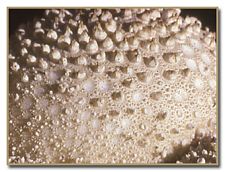Lycoperdon perlatum
 Gem-studded Puffball
Gem-studded Puffball
Order Agaricales, family Agaricaceae
FRUITING BODY PEAR-SHAPED, NARROWED BASE; SMALL SPINES
2-6 cm wide, 3-8 cm high; pear- or top-shaped, with narrowed, stalk-like base; base often wrinkled
Outer layer of skin with cone-shaped spines that leave scars; white to gray or brown
SPORE MASS inside mushroom white, then yellow, olive-brown, and finally powdery
Spores escape ("puff") through pore at top

ON GROUND, GRASS, OFTEN CLUSTERED
EDIBLE WHEN FIRM AND WHITE INSIDE
Lookalikes:
L. pyriforme -- no spines when young
YOU MIGHT ALSO LIKE TO KNOW....
Young, edible "puffballs" are roundish and solid white, ranging in size from a penny to a basketball. When they're older and begin to dry out, the white mass inside the ball becomes brown and powdery. At this stage, if you squeeze the ball, the powder will "puff" out the top of the fungus, hence the name puffball. Sometimes the entire top of the ball will break away, and the powder will spill out of the remaining cup-like structure. The powder is composed of spores --billions or trillions (!) of them in large puffballs—which are the basic reproductive units of a shroom. (See the “Identifying Urban Mushrooms” section of this website.)
Puffballs are not the same as truffles, the famous gourmet mushrooms, especially the famous white truffle of Italy. Truffles are potato-shaped with a marble interior and grow underground. Truffles smell like a pig pheromone, which is a sexual attractant. This explains why pigs were used by farmers to sniff out truffles. Unfortunately, pigs eat about 20 percent of the truffles they find. So, easier-to-train dogs are now used. In another victory for the world of automation, a truffle-detecting machine has been developed, which is guaranteed not to eat the truffles. In any case, truffles have been found in some cities, but they are hard to find and identify.
Lycoperdon perlatum is an edible puffball, but like other edible puffballs, only when it is young and completely white inside. If you cut the fungus in half and it appears yellowish or brownish, it is no longer safe to eat. (Some people cut away the yellowing part of the fungus on larger specimens and eat the white part with no ill effects.) If you cut through it and it's purple black, it's probably a poisonous species. Also, when you cut it in half, be sure your "puffball" is not actually the button or egg stage of a different kind of mushroom. If it is, you will see the outline of a mushroom in the white interior of the egg.
The gem-studded puffball frequently grows close to curbs, near trampled ground, or areas where grass is present but not dense. It's not found in mulched flower beds. Look for the detachable conical spines.
Puffballs are versatile. Their flavor is delicate and the small size adds visual effect to egg, chicken, veal and fish dishes. Be sure to clean your specimens before cutting them. The interior is highly absorbent and will get quite soggy if you rinse after cutting. You are well advised to cut even small specimens in half. Make sure they are white like a cottonball throughout.
It is not always easy to find a lot of puffballs, but when you do, consider using them in a salad as a delicious and colorful way to start your meal. The edible flower petals and white puffballs are beautiful on a bed of mixed greens. Make the dressing at least six hours prior to serving.
Marigold and Puffball Salad
4 c puffballs, cleaned and halved
2 T vegetable oil
2 T fresh thyme leaves
1 head red leaf lettuce
1 c mixed strong greens (arugula, escarole, dandelion, mustard, etc.)
1/3 c sunflower seeds
2/3 c marigold petals (snip off the bitter base end)
In a large frying pan, quickly stir fry the puffballs in the hot vegetable oil. Remove them from the pan and set aside while you prepare the greens. Everything can be chilled in separate containers until ready to serve. Upon serving, arrange the greens on individual plates, top them with mushrooms, then garnish with sun seeds and marigold petals. Pass the dressing at the table.
Dressing
2 t fresh lemon zest
1 lemon, juiced
1 t fresh thyme leaves, chopped
1 small clove garlic, minced
½ c white wine vinegar
1/3 c mild olive oil
Place all ingredients in a bottle and refrigerate for at least six hours to give the herbs time to marry. Shake before pouring.


